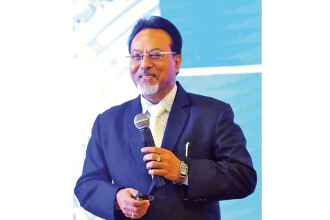
Chandan Sapkota is an economist with expertise in macroeconomic analysis, public policy and policy analysis. Currently, he is a Senior Fellow at Nepal Economic Forum, and is pursuing doctorate degree in economics at National Graduate Institute for Policy Studies (GRIPS) in Tokyo. He regularly contributes economic and political analysis focusing on Nepal and India to the Economist Intelligence Unit (EIU), and analytical opinion articles to a national daily.
Sapkota worked as an economics officer at Asian Development Bank, Nepal Resident Mission (ADB NRM); a researcher at South Asia Watch on Trade, Economics and Environment (SAWTEE) in Kathmandu; a junior fellow at Carnegie Endowment for International Peace (CEIP) in Washington, DC; and an op-ed columnist for Republica. He has also worked as a consultant for the government and several multilateral and bilateral development institutions.
His research papers are published in peer-reviewed development journals. He is frequently interviewed and quoted by international and national media including in The New York Times, The Wall Street Journal, The Economist, The Guardian, Nikkei Asian Review, Deutsche Welle (DW), AFP, Al Jazeera, and various Nepali print and online media. Sapkota is also a frequent blogger at www.sapkotac.blogspot.com and is active on Twitter @csapkota.
Sapkota was in Nepal in May for a brief visit during which he was part of an event titled ‘Ke Samriddhi, Kosko Samriddhi’ in which he spoke about the current economic state of Nepal, and his ongoing research and findings.
B360 had an opportunity to question Sapkota about Nepal’s economy and challenges.
Excerpts from the interview:
During your presentation at the event organised by Nepal Economic Forum, you stated that if the government invests in a sector, then private investment will also increase by about threefold. You also mentioned in one of your articles that private gross fixed investment, which averaged 23% of GDP in the last five years also needs to increase so that total gross fixed investment is at least above 30% of GDP. What are the key areas that you have identified which the government and private sector should invest in? Why?
Increasing both private and public investment in productivity and enhancing infrastructure is essential to accelerate economic activities and to achieve GDP growth of over 7%. Gross fixed capital formation is gradually increasing since FY2015 but it is still below the average of low income countries. The government should create an enabling legal, regulatory and institutional framework to facilitate domestic and foreign investment. It should also make a concerted effort to increase capital spending to around 8% to 12% of GDP annually.
Investment in seven key sectors has the potential to accelerate growth, which could be inclusive as well as sustainable: high value agriculture, road and air transport, tourism, energy, light manufacturing, urban development, and education/ICT and skills. These strategic sectors have their own characteristics that make them stand out as the most promising ones given Nepal’s per capita income, market access to key export destinations, demography, natural resources, macroeconomic stability, geography and ability to quickly absorb technology transfer and technical know how.
In one of your recent articles published in a daily newspaper, you mentioned “the appointment of Yubaraj Khatiwada as finance minister by Prime Minister KP Sharma Oli is the right decision given the likelihood of inflation to rise to 6%, bank credit getting tighter, and the external situation deteriorating.” Do you still hold that thought?
Dr. Yubaraj Khatiwada as a finance minister at this critical juncture is the most appropriate decision given the options the left alliance (now Nepal Communist Party) had. Although his white paper had serious shortcomings, especially on attribution of accumulated economic ills and bad aspects of privatisation to Nepali Congress only (the communist parties also led the government in the past and they either did nothing or contributed to aggravate the situation), he managed to portray an honest assessment of the core economic issues over the last decade.
Yes, GDP growth was stellar in the last two years, but we should not forget that these are probably outliers (FY2017 was base effect and FY2018 was fiscal stimulus in the form of elections spending and post earthquake reconstruction). This should not mask the reality that growth remains volatile and is dictated by monsoon rains and remittance income; inflation is ratcheting up; capital spending is chronically low given the budgeted amount; financial sector is beset by recurring asset liability mismatches and liquidity squeezes; and trade deficit is ever-increasing. Prudent fiscal and external sector management are essential to macroeconomic stability, which is a key determinant of private domestic and foreign investment.
With a background in economics, policymaking at National Planning Commission and as governor of Central Bank, Dr. Khatiwada has the required understanding on these issues to lead the Finance Ministry at this point in time. However, he will face a hard time managing expectations, promoting competitive federalism, and ensuring a coordinated calibration of policies.
 As an economist, how do you forsee Nepal’s future considering that we continue to count on monsoon and remittance to lift us up economically. Moreover, in FY 2017 the GDP growth was at 7.4% but Central Bureau of Statistics (CBS) estimates 5.9% in FY 2018. Agricultural output and industrial output are estimated to be down in 2018 in contrast to 2017.
As an economist, how do you forsee Nepal’s future considering that we continue to count on monsoon and remittance to lift us up economically. Moreover, in FY 2017 the GDP growth was at 7.4% but Central Bureau of Statistics (CBS) estimates 5.9% in FY 2018. Agricultural output and industrial output are estimated to be down in 2018 in contrast to 2017.
The future is definitely not bleak if the government manages finances prudently, synchronises fundamental policies and priorities of all tiers of government to create a coherent economic development plan and strategy, increases productivity-enhancing investment, and relaxes rigid business regulations by continuing “second generation reforms”. Delivery of committed outputs within a stipulated time by both government agencies and private contractors will be something we need to watch out for. These alone have the potential to transition the economy from remittance-backed activities to more stable sources of growth that not only generate adequate jobs but also are inclusive. Therefore, yes, there is ample ground to be optimistic, but it all depends on how the government does its business, i.e. facilitates investment or just rolls out redistributive programs to please voter base.
For Nepal to become a middle-income country by 2030, what are its major macroeconomic challenges?
As mentioned earlier, the core challenge is to transition from a remittance-dependent economy to one that is largely driven by domestic factors. In order words, we need to ensure that the pace and pattern of economic growth and development are supported by a vibrant industrial sector, higher absorption of unemployed workforce in productive sectors, and production of high-valued, high-productivity goods and services across all sectors. I see six key macroeconomic challenges:
• Sources of growth have to be reliable, which means less reliance on monsoon rains for agricultural output growth and on remittance-backed demand for services output growth. This is possible by increasing investment to tackle the most binding constraints to growth, i.e. inadequate supply of infrastructure (energy, transport and irrigation).
• Fiscal management will be challenging given large spending needs and stagnating growth of revenue. This is aggravated by low quality and quantum of public capital spending.
• High and volatile inflation which is affected by both domestic supply-side constraints and prices in India which is another major challenge to boost private investment.
• There is a lingering risk of financial sector instability arising from recurring sources (accumulation of unbalanced portfolio, lax monitoring and supervision, and asset-liability mismatch).
• Slow progress post-earthquake reconstruction would mean local economic activities below potential.
• Increased import amidst stagnating exports and decelerating remittance income will widen current account deficit and reduce foreign exchange reserves. This needs to be managed well by promoting export and import competing domestic production of goods and services.
How does the general understanding that the country’s economic state is dictated by its political state matter? And what does it say about Nepal where political stability has been reduced to a concept? Is this a problem you have identified to the whole of South Asia?
Generally, political stability increases investor confidence and hence investment, which then contributes to accelerate economic activities. Even with some degree of political instability, some countries (such as Bangladesh) have managed to clock in high and sustained growth rate largely due to stable and effective bureaucracy. This is the missing piece in Nepal. Changes to government leadership are followed by changes to bureaucracy resulting in high turnover of staff in key projects and erosion of institutional memory. It substantially reduces pace of work as new staff have to reinvent the wheel in terms of understanding project’s physical and financial work plan. Furthermore, new staff are usually hesitant to fully own reform initiatives (for policy formulation or amendment of existing ones) agreed with stakeholders in the past.
Two of your research interests are South Asian economy and policy analysis. Which one country in South Asia do you think has the potential to rise economically because of the introduction of correct policies?
India is obviously the most dynamic economy in South Asia. The present government has initiated landmark reforms on digitization, tax structure, healthcare, rural agriculture, monetary policy committee, bankruptcy, industrialisation and easing of business regulations. No wonder the ruling party and its allies have swept power in 21 of 29 states.
How do cartels and syndicates affect a country’s economic cycle? Recently the government of Nepal set a firm tone against transport syndicate. Demand for dismissal of cartels in the banking sector, pharmacy, food industry is high from the civil society. Your thoughts.
Cartels/syndicates tend to protect member business interests by capturing markets, i.e. preventing creative creation and creative destruction (which in effect help them to either control prices or quantity or both). These anti-competitive practices are fostered through political or business patronage and stifle innovation. These are most prominent in transport and banking sectors, resulting in high cost of doing business. There is collusion among construction companies and a handful of them secure all the big contracts. The level of capture of contracts, permits and business exclusivity is staggering. There is so much of interlinkages between politics and cartels that it is hard to do away with them in one go. There are cartels in public transport, freight and petroleum transport, agriculture, education, healthcare, banks and airlines, among others. However, recent government effort to clamp down hard on transport syndicates and contractors is a welcome move. We will need to see if these efforts are just window dressing of core problems to placate voter base or they are genuine reform measures that the government will take to a logical end. Nepal still does not have a competition commission to look at these issues at the institutional level.





